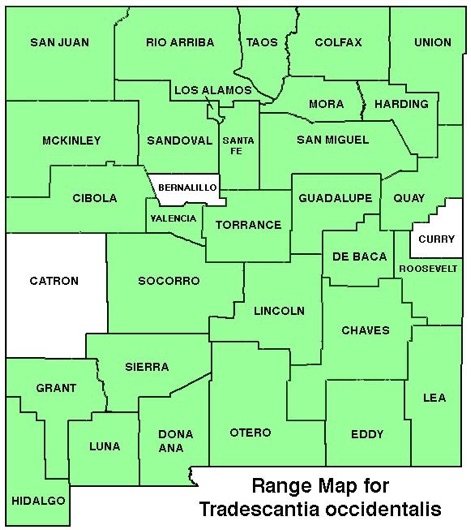WILDFLOWERS OF NEW MEXICO

Two long, slender, leaf-like bracts spread from underneath the cluster of blue to magenta flowers from the tips and leaf nodes of fleshy, succulent stems that reach 20-inches tall. Note the stems are branching, smooth, hairless, and covered with a waxy, whitish coating.
FLOWER: April–August. An open cluster at the stem tip and nodes has from a few to many flowers on stem-like pedicels 3/8–1 1/4-inch long (8-30 mm). The bright-blue to lavender or rose-colored flowers have 3 oval petals 1/4–3/4-inch long (7–16 mm), and 6 stamens with purple bearded filaments and yellow anthers. In var. occidentalis, sepals enclosing the buds are hairy; in var. scopulorum they are hairless.
LEAVES: Alternate. Blades narrow, to 12-inches long (30 cm) and 3/4-inch wide (2 cm), with parallel veins. The blades are smooth, hairless, waxy, folded along the midvein, and the base sheaths the stem.
HABITAT: Sandy soils, roadsides, disturbed areas; shortgrass prairies, foothills, pinyon-juniper, ponderosa forests.
ELEVATION: 4,300–8,000 feet.
RANGE: AZ to Mississippi River and north into Canada.
SIMILAR SPECIES: 3 species in NM. Wright’s Spiderwort, T. wrightii, in the se 1/4 of NM, has smooth, hairless stems without branches and flower petals to 3/8-inch long (1 cm). Pinewoods Spiderwort, T. pinetorum, the western 1/2 of NM, has usually unbranching stems, petals 3/8–1/2-inch long (9–12 mm), and leaf sheaths with small hairs. Two Dayflowers, Commelina dianthifolia, and Commelina erecta, have flower buds enclosed in a boat-like spathe, hairless filaments, and do not have the two long bracts extending from underneath the flowers.
NM COUNTIES: Nearly statewide (not reported from Bernalillo, Catron, Curry counties) in low- to mid- elevation sandy habitats.

WESTERN (PRAIRIE) SPIDERWORT
TRADESCANTIA OCCIDENTALIS
Spiderwort Family, Commelinaceae
Perennial herb


THE CONTENTS OF THIS WEBSITE ARE COPYRIGHTED AND CANNOT BE USED
WITHOUT PERMISSION OF GEORGE OXFORD MILLER

Bearded, or hairy, filaments have bright yellow anthers.

-
•Two slender, leaf-like bracts spread out from underneath the flowers (upper arrows).
• In var. occidentalis, the sepals (lower arrow) enclosing the buds are hairy; in var. scopulorum they are hairless.




bract
bract
sepals

pedicels
EMAIL ME